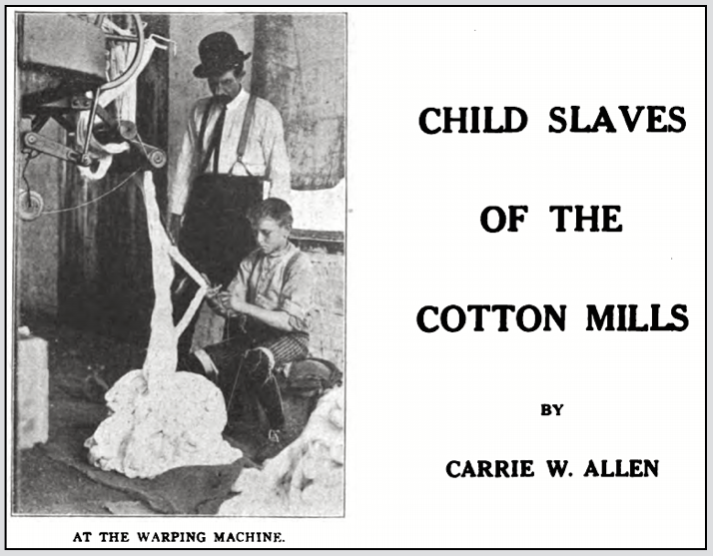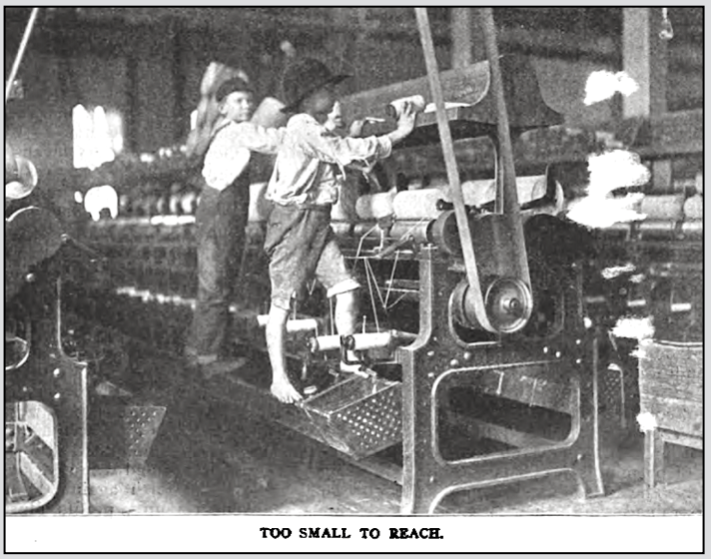 ———-
———-
Hellraisers Journal – Sunday March 5, 1911
Carrie W. Allen on Child Slaves of the Cotton Mills, Part II
From the International Socialist Review of March 1911:
[Part II of II.]
The Senate report already quoted gives this verbatim statement from one of the federal agents concerning a mill in North Carolina:
The mill employs many children, and the smallest I have seen working in any mills. I asked five exceptionally small ones how old each was and each answered, “I don’t know.” These children, the superintendent says, work from 6 p. m. to 6 a. m. * * * I know, beyond a reasonable doubt, that there are ten or twelve children under twelve years of age working in the mill, seven or eight of them at night.
One of the children is an emaciated little elf fifty inches high, and weighing perhaps forty-eight pounds, who works from 6 at night till 6 in the morning, and who is so tiny that she has to climb upon the spinning frame to reach the top row of spindles.
Instances might be multiplied of the criminally long hours these little victims are imprisoned in the mills, no sound reaching them except the racking whirr of the machinery, no air reaching their choked lungs except the fluff laden air of the dusty factory.
Is it any wonder that these poor little over-wrought beings under continuous nervous strain, frequently have their fingers and hands caught in the cruel cogs, which lacerate and tear and frequently cripple them? One hundred and twenty-two mills reported 1,241 accidents for a year, and it is known that these figures are only partial, as mill owners only report accidents when forced to do so.
Many of the children insist that they prefer night work, as the threads run so much smoother, and do not so frequently break. This saves them from the “reproof” of the overseer, and the fine that is docked from their slender pay when anything goes wrong with the work. Poor care-laden little ones, terrorized into such a condition of mind that they really prefer the fatiguing night work.
Not content with the profits which may be sweated out of the children, an additional pressure upon them by the system of premiums which is used in many mills. The tired children are already overstrained and their endurance stretched to the breaking point. It is pernicious to drive them to further exertion to add a pitiful sum to the niggardly wage.
The real object of premiums is to increase the production of the worker in order to increase the profits of the mill owner. For instance, a premium of fifty cents a week is paid to weavers who tend their looms during the lunch hour. Spoolers who spool ten boxes of cotton yarn a day are paid the price of a box, nine cents extra, and for spooling fifteen boxes a premium of eighteen cents is given. Pennies in premiums for the life energy of the children; dollars in profits for the pockets of the masters!
The home life of the mill children is barren and desolate, especially for the ones who keep up their goblin dance from one spindle to another all through the long weary hours of the night, and jaded and wan come creeping home in the gruesome dawn.
We need not wonder that the overstrained, undeveloped little ones have so little vital resistance that they early fall victims of disease. The anemic condition of the blood, the nerve-racking strain of the work, and the dust laden atmosphere close every avenue of health, and dropsy, tuberculosis and other wasting diseases claim many of the children of the cotton mills.
One of the gravest indictments of the wretched industrial chaos under which we live is the inhuman treatment meted out to the children of the nation. Every advance of modern machinery means that more and more of these helpless little ones are caught between the upper and nether millstones, and remorselessly ground into profits.
It is impossible for a nation to thrive that grinds up and destroys its children. The boys and girls are the nation’s greatest asset; they are the nation of tomorrow, and the sooner we wake up and put an end to the hideous wrongs daily heaped upon the children of the working class, the better for the race.
At the dawn of each new day, a gaunt army of half awakened children are swallowed up by the hideous cotton mills, and at night, weary and wan and joyless, they are spewed forth again. Spindles must be kept running, profits must be made, even though pale-faced children droop and wither and die.
———-
[Emphasis added.]
~~~~~~~~~~~~~~~~~~~~~~
SOURCES & IMAGES
Mother Jones Quote, Child Labor Man of Six Snuff Sniffer
https://www.iww.org/history/library/MotherJones/autobiography/14
The International Socialist Review, Volume 11
(Chicago, Illinois)
-July 1910 to June 1911
Charles H. Kerr & Company, 1911
https://www.marxists.org/history/usa/pubs/isr/
https://books.google.com/books?id=8-05AQAAMAAJ
ISR – Mar 1911
https://www.marxists.org/history/usa/pubs/isr/v11n09-mar-1911-ISR-gog-Corn-OCR.pdf
See also
Hellraisers Journal – Saturday March 4, 1911
Carrie W. Allen on Child Slaves of the Cotton Mills, Part I
Tag: Carrie Allen
https://weneverforget.org/tag/carrie-allen/
Tag: Lewis Hine
https://weneverforget.org/tag/lewis-hine/
Dec 1908
Boy at warping machine, Catawba Cotton Mill, Newton, N.C. Location: Newton, North Carolina.
-by Lewis Hine
https://www.loc.gov/pictures/item/2018674970/
Jan 19, 1909
Bibb Mill No. 1-Many youngsters here. Some boys were so small they had to climb up on the spinning frame to mend the broken threads and put back the empty bobbins. Location: Macon, Georgia.
https://www.loc.gov/pictures/item/2018674998/
Tag: National Child Labor Committee
https://weneverforget.org/tag/national-child-labor-committee/
Women in Industry Series, Issues 5-8
U. S. Bureau of Labor Statistics, 1916
https://books.google.com/books?id=7DEKAQAAMAAJ
Summary of the Report on Condition of Woman and Child Wage Earners in the United States
https://play.google.com/books/reader?id=7DEKAQAAMAAJ&hl=en&pg=GBS.PA1
Chapter I.-The Cotton Industry
https://play.google.com/books/reader?id=7DEKAQAAMAAJ&hl=en&pg=GBS.PA37
~~~~~~~~~~~~~~~~~~~~~~~~~~~~~~~~~~~~~
Dorsey Dixon- Babies In The Mill


